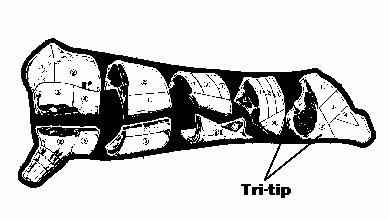Special Feature: Products Sally Recommends
Oven Roasted Tri Tip
I will confess that I love meat and I am not alone in sharing this carnivorous inclination with many others. Each day in the U.S. 76 million portions of beef are served. Pork is not far behind in popularity. And we can't forget lamb and veal. This column is written for all of us where meat matters as an important part of our diet and enjoyment. Whether you enjoy meat every day, once a week, or on special occasions, you may have noticed that our meat ain't what it used to be, especially our two favorites, beef and pork. Because of continued pressures to lower the fat in the American diet, ranchers have responded by putting their pigs and cattle on a serious slimming program. The result is meat with less marbling (intra-muscular fat). Less marbling means meat with less flavor, juiciness and a tendency to dry out when even slightly over-cooked (remember those dry hard pork chops you had recently). The goal of this column is to help you cook the leaner meat we buy today so that it's tender, juicy and full of flavor. The methods are simple, involving the proper use of seasoning and marinades and paying special attention to cooking methods and techniques.

The changes that have made America's meat supply much leaner have occurred in the last 10-20 years and are still in process. Most new and all older cookbooks tell you how to cook meat from a former time. These books are of no value to you, especially if you follow instructions to cook pork chops to an internal temperature of 170-180 degrees F, you will not be happy. So don't be alarmed when I tell you that meat is done at lower internal temperatures that what you are used to reading in older cookbooks. Instead of using cooking times as the critical measure of telling when something is done, I strongly recommend the internal temperature of the meat itself as the critical measure of doneness. This can be easily done with an instant-read thermometer. Those with a digital readout measure the temperature at their tip and can be used for thinner cuts such as steak but even the less expensive dial type is quite adequate for most meat cookery. Your investment for even the digital thermometers is less that $20 and they more than pay for itself when you produce your first roast of perfectly cooked beef or pork.
To get you started on meat cookery I want to pick something both simple to prepare and delicious to eat. Beef tri-tip fits this bill. It's a delicious and quick way to serve a roast beef dinner for a family of 2-6 persons and leftovers make great sandwiches.
![]()
Oven Roasted Tri-Tip
1 teaspoon salt
1/2 teaspoon freshly ground black pepper
1 tablespoon finely chopped garlic
Dry rub or marinade of your choice.1 1/2 to 2 1/2 pound beef tri-tip, fat trimmed to 1/4 inch
Pan Sauce: (do not make if you use a wet marinade)
1/2 cup beef or chicken stock
1/4 cup red wine
1 teaspoon chopped fresh herb of your choice such as thyme or rosemary, or 1/2 teaspoon dried
1 tablespoon Dijon mustard
Salt and freshly ground black pepper
Flavor Step: If you're using the garlic rub or a dry rub, combine all ingredients and generously season or rub the meat all over and let it stand at room temperature for up to 2 hours. Or cover the roast and leave it overnight in the refrigerator; let it sit at room temperature for 2 hours before cooking. If you're using a wet marinade, puncture the meat all over with a meat fork or skewer. Place it in a zip-lock bag or large bowl and pour the marinade over the meat. Marinate (cover if using a bowl), for up to 2 hours at room temperature or overnight in the refrigerator. If the meat has been refrigerated, let it sit at room temperature for 2 hours before cooking.
Preheat the oven to 450 degrees F. Remove the meat from the marinade and pat it dry. Discard the marinade. Place the tri-tip, fat side up, on a rack in a shallow roasting pan. Roast for 20 minutes, then begin checking the internal temperature: You should remove the roast at 115 degrees F to 120 degrees F for rare, 120 degrees F to 125 degrees F for medium-rare.
Transfer the meat to a carving board or platter, cover loosely with foil, and let it rest for 10 to 15 minutes before carving to allow the residual heat to complete the cooking and the juices to stabilize.
Meanwhile, make the optional pan sauce: Pour off any fat from the roasting pan. Place the pan over a burner and add the stock, wine, and herbs. Bring to a boil, scraping up any browned bits from the bottom of the pan. Reduce the sauce almost to a syrup. Whisk in the mustard and taste for salt and pepper.
Slice the meat into thin slices across the grain. If you made the sauce, pour it over the sliced meat, and serve.
![]()
Bruce Aidells is the founder of Aidells Sausage Company & has written and co-authored nine cookbooks including meat and poultry chapters for The New Joy of Cooking.
Note: This information was accurate when it was published. Please be sure to confirm all rates and details directly with the businesses in question before making your plans.



